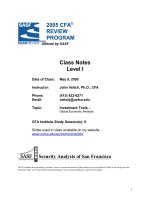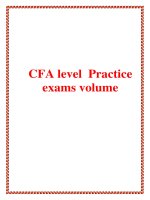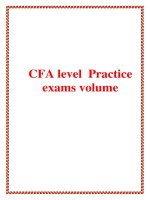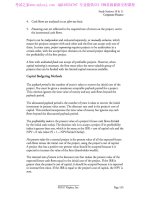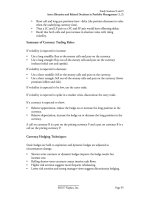CFA CFA level 3 CFA level 3 CFA level 3 CFA level 3 CFA volume 2 finquiz smart summary, study session 5, reading 11
Bạn đang xem bản rút gọn của tài liệu. Xem và tải ngay bản đầy đủ của tài liệu tại đây (78.42 KB, 7 trang )
2018 Study Session # 5, Reading # 11
“CONCENTRATED SINGLE-ASSET POSITIONS”
CP = Concentrated Position
EM = Equity Monetization
1. INTRODUCTION
Three major types of concentrated positions in a single asset:
Publicly traded stock.
Privately owned business.
Commercial or investment real estate.
Concentrated positions are often illiquid assets.
2. CONCENTRATED SINGLE-ASSET POSITIONS: OVERVIEW
No universally accepted threshold exists for concentrated position.
CP is often a long period held position with very low cost basis.
Publicly traded single-stock positions:
Ways an investor can end up owning a concentrated stock position:
Part of executive compensation.
Received a significant amount of stock in share-based sales
transaction.
Came from long term buy-end-hold investing strategy.
Privately owned business:
Usually private businesses with ownership transfer from one generation
to next.
Investment real estate.
Commercial or industrial real estate typically held for a long-term period.
2.1 Investment Risks of Concentrated Positions
2.1.1 Systematic Risk
Can’t be eliminated by holding a welldiversified portfolio.
Multiple sources of systematic risk
e.g. business cycle, inflation etc.
2.1.3 Property-Specific Risk
Unsystematic risk of owning a particular
piece of real estate
2.1.2 Company-Specific Risk
Non-systematic or idiosyncratic risk
to a particular company’s operations,
reputation & business environment.
High level of company specific risk
exists in a CP.
the volatility with company
specific risks of single-stock holdings,
the benefit of higher capital
accumulation.
Copyright © FinQuiz.com. All rights reserved.
2018 Study Session # 5, Reading # 11
3. GENERAL PRINCIPLES OF MANAGING CONCENTRATED SINGLE-ASSET POSITIONS
3.1 Objectives in Dealing with Concentrated Positions
3.1.1 Typical Objectives
3.1.2 Client Objectives and Concerns
Reduce the risk of wealth
accumulation.
To generate liquidity to diversify &
satisfy spending needs.
To optimize tax efficiency.
Many objectives that the owner of
the CP might wish to achieve
including:
To maintain effective control.
To enhance current income.
3.2 Considerations Affecting All Concentrated Positions
3.2.1 Tax Consequences of an Outright Sale
Significant taxable capital gains possible in
CP due to lower cost basis.
Primary objective ⇒ deferring or
eliminating C.G tax if possible.
3.2.2 Liquidity
CP is generally illiquid.
Illiquidity generally acts as a
constraint with a CP.
3.3 Institutional and Capital Market Constraints
3.3.1 Margin-Lending Rules
3.3.2 Securities Laws and Regulations
If the purpose of the loan is to buy
additional securities, the maximum
loan proceeds are usually quite
limited.
Company insiders & executives must
often comply with these law’s
3.3.3 Contractual Restrictions and Employer Mandates
These generally restrict the flexibility of insider &
employees to either sell or hedge their shares & include
lockups or blackout periods
3.3.4 Capital Market Limitations
Various characteristics of the
underlying stock determine the
feasibility of hedging different CPs &
degree of hedge.
3.4 Psychological Considerations2
3.4.1 Emotional Biases
Following emotional biases can –vely affect the decision
making of holders of CPs:
Familiarity & overconfidence bias.
Status quo bias.
Endowment effect.
Careful handling of client to overcome emotional
biases.
3.4.2 Cognitive Biases
These include:
Conservatism & confirmation bias.
Illusion of control, anchoring & adjustment.
Availability heuristic.
Copyright © FinQuiz.com. All rights reserved.
2018 Study Session # 5, Reading # 11
3.5 Goal-Based Planning in the Concentrated-Position Decision-Making Process
Goal based planning ⇒ one way to incorporate psychological considerations into
allocation & portfolio construction.
Personal risk bucket:
Goal is to protect from poverty or dramatic in life style.
Yield below market return but limit losses.
Market risk bucket:
Objective is to maintain current living standard.
Avg. risk adjusted market return (stock & bond portfolio).
Aspirational risk bucket:
Objective is to wealth substantially.
Above market expected return but with substantial risk of loss of capital.
Primary capital ⇒ minimum amount to maintain owner’s lifetime spending needs
(usually allocated to personal & market risk bucket).
Surplus capital ⇒ allocation to aspirational risk bucket.
3.6 Asset location and Wealth Transfers
Asset location decision ⇒ choice of where to place specific assets (different from
asset allocation decision).
Usually used to minimize transfer tax.
Wealth transfers
Early planning of wealth transfer enables the owner to shift future wealth with
little or no transfer tax.
Direct gifting is suitable before the concentrated position has appreciated
greatly.
Estate tax freeze ⇒ owners transfer a junior equity interest to the children that
will receive most or all of the future appreciation of the enterprise.
After significant appreciation, technique include:
Contribute the CP to an entity such as family limited partnership.
3.7 Concentrated Wealth Decision Making: A Five-Step Process
Five step process that best satisfy the objectives of holders of CPs.
Identify & establish objectives & constraints.
Identify tools that can satisfy these objectives.
Compare tax advantages & disadvantages.
Compare non-tax advantage & disadvantages.
Formulate & document an overall strategy.
4. MANAGING THE RISK OF CONCENTRATED SINGLE – STOCK POSITIONS
Diversification generally considered prudent to minimize risk from CPs.
Tools to mitigate the risks of concentrated position.
Outright sale ⇒ give funds but often incurs significant tax liabilities.
Monetization strategies ⇒ these provide owners with funds without
triggering a taxable event (e.g. loan against CPs).
Hedging the value of the concentrated asset through derivative.
Copyright © FinQuiz.com. All rights reserved.
2018 Study Session # 5, Reading # 11
4.1 Introduction to Key Tax Considerations
Internal inconsistency of tax codes provides an
opportunity for well diversified investors to reap
substantial tax savings.
4.2 Introduction to Key Non-Tax Considerations
Key non-tax considerations when deciding whether to use an
exchange traded or OTC derivative including:
Counterparty credit risk.
Ability to close out transaction prior to stated expiration.
Price discovery & transparency of fees.
Flexibility of terms.
Minimum size constraints.
4.3 Strategies
Three common strategies that investors use in the case of a CP in a
common stock.
Equity monetization.
Hedging.
Yields enhancement.
4.3.1 Equity Monetization
Equity monetization ⇒ transformation of a CP into cash usually in a
way to avoid current taxable event.
EM entails a two step process.
To remove a large position of risk inherent in the CP (hedging).
To borrow against the hedged positions.
4.3.1.1 Equity Monetization Tool Set
A Short sale against the box
Shorting a security that is held long.
Any future ∆ in stock price will have no effect on the
investor’s economic position.
Investor will earn money market return.
Least expensive technique.
A total return equity SWAP
Contract for a series of exchanges of the total return
on a specified asset in return for specified fixed or
floating payments.
Investor is fully hedged as in short sale strategy.
Money market rerun slightly less than what would be
on short sale strategy.
Forward conversion with options
Equity forward sale contract
Synthetic short forward positions against the asset
held long.
Pay off of a short forward = pay off of a long put & a
short call on same asset.
Money market return.
Private contract for the forward sale
of an equity position.
Money market returns
Copyright © FinQuiz.com. All rights reserved.
2018 Study Session # 5, Reading # 11
4.3.1.2 Tax Treatment of Equity Monetization Strategies
EM eliminates concentration risk & generates cash approximately equal to
outright sale.
Critical question ⇒ whether an EM strategy will be treated as a taxable
event for tax purpose in a particular country.
4.3.2 Lock-in Unrealized Gains: Hedging
4.3.2.1 Purchase of Puts
4.3.2.2 Cashless (Zero-Premium) Collars
Investors of CP can buy put option to
Lock in floor price.
Retain unlimited upside.
Defer CG tax.
Investor is fully protected against price risk.
Long stock + long put position is extremely appealing
but costly.
Knock-out option ⇒ exotic option that can be
acquired only through OTC dealer (less expensive
option).
4.3.2.3 Prepaid Variable Forwards
These are used to:
Hedge price risk.
Retain certain degree of upside.
Defer CG tax.
Structure ⇒ buy puts (at or out-of-the money) &
sell calls with same maturity.
Strike price of calls is set at the level exactly to
amount required to pay for puts.
Investment risk is but not eliminated.
4.3.2.4 Choosing the Best Hedging Strategy
PVF ⇒ an agreement to sell a security at a specific time
in the future with the number of shares to be delivered
at maturity (varying with the underlying share price at
maturity)
Tax characteristics of the shares that are being hedged
can help determine which strategy will deliver the
optimal result for client.
4.3.3 Yield Enhancement
Investors can enhance the yield of a CP while its volatility by writing
covered calls against some or all of the shares.
Premium income through selling call options.
Investors retain full downside exposure to the shares.
Most significant benefit of covered call writing ⇒ to psychologically
prepare the owner to dispose of those shares.
4.3.4 Other Tools: Tax-Optimized Equity Strategies
Combine investment & tax considerations in making investment decisions.
Index tracking strategy with active tax management ⇒ designed to track a
broad based market index on a pretax basis & outperform it on an after tax
basis.
Construction of completeness portfolios ⇒ builds a portfolio such that
combination of the two portfolio tracks the broadly diversified market
benchmark.
Copyright © FinQuiz.com. All rights reserved.
2018 Study Session # 5, Reading # 11
4.3.5 Other Tools: Cross Hedging
Cross hedging ⇒ using derivative on a substitute asset with an expected
high correlation with the investor’s concentrated position.
Investor is at least able to hedge market & industry risk (company specific
risk retains).
4.3.6 Exchange Funds
Exchange fund ⇒ partnership in which the partners have each contributed
their low basis CP to the fund.
Pro-rata holding of diversified pool of securities with minimum period of
7years.
Pro-rata ownership at redemption.
5. MANAGING THE RISK OF PRIVATE BUSINESS EQUITY
High percentage of private clients derives their wealth from the ownership
of a privately owned business.
Private business owners are often asset rich but relatively cash poor.
5.3 Monetization Strategies for Business Owners
5.3.1 Sale to Strategic Buyers
Strategic buyer ⇒ competitors or other companies
involved in the same or a similar industry as the
seller.
Highest price due to potential synergies.
5.3.3 Recapitalization
Leveraged recapitalization ⇒ leveraging of a
company’s balance sheet.
Attractive for owners who would like to the risk of
their wealth concentration.
5.3.5 Divestiture (Sale or Disposition of Non-Core Assets)
Divestiture ⇒ sale of non-core assets.
Owner continues to run business but generate liquidity
through divestiture.
5.3.7 Personal Line of Credit Secured by Company Shares
5.3.2 Sale to Financial Buyers
These are private equity firms that typically raise
funds from institutional investors.
Pay price which is lower than strategic buyer’s
price.
5.3.4 Sale to Management or Key Employees
Employees or senior managers can acquire
control of business through a management
buyout.
Key risk ⇒ employees may not be successful
entrepreneurs.
Failed attempt to do an MBO has the potential
to –vely affect the dynamics of employeremployee relationship
5.3.6Sale or Gift to Family Member or Next Generation
Sell or transfer through a combination of tax
advantaged gifting strategies.
Transfer is typically made to family members or
members who actively involved in business.
Owner might consider arranging a personal loan
secured by his/her share in private company.
Key benefits ⇒ no immediate taxable event.
Copyright © FinQuiz.com. All rights reserved.
2018 Study Session # 5, Reading # 11
5.3 Monetization Strategies for Business Owners
5.3.8 Going Public through an Initial Public Offering
IPO is possible if the company is in an industry
deemed attractive by investors.
Significant cost of going public but usually price of
the deal is very attractive.
IPO is not a viable exit strategy if owner’s objective is
to exit from the company.
5.3.9 Employee Stock Ownership Plan
Sale of company’s shares to certain type of
pension plans.
Leveraged ESOP ⇒ ESOP borrows funds to
finance the purchase of the owner’s shares.
5.4 Considerations in Evaluating Different Strategies
Objective ⇒ to maximize the after-tax proceeds as opposed to simply
maximizing the sale price.
Different strategies may result in different values for the company that is
being sold or monetized.
Strategic buyers typically pay the highest price for a business.
6. MANAGING THE RISK OF INVESTMENT REAL ESTATE
Real estate owners are often exposed to significant degree of
concentration risk & illiquidity.
Various forms of debt & equity financing to facilitate monetization.
6.1 Monetization Strategies for Real Estate Owners
6.1.1 Mortgage Financing
Mortgage financing can be used to generate liquidity
to diversify asset portfolios (no taxable event).
Non-recourse loan ⇒ lender’s only recourse upon an
event of default is to look to the property that was
mortgaged to lender.
6.1.2 Real Estate Monetization for the Charitably Inclined
Asset location is also important for real estate.
Many tools & techniques can be used by charitably
inclined clients under different tax regimes to monetize
real estate.
6.1.3 Sale and Leaseback
6.1.4 Other Real Estate Monetization Techniques
Owner sells the property & then immediately leases
it back from the buyer at a rental rate & lease term
that is acceptable to new owner.
Primary goal ⇒ free up the owner’s equity for other
uses while retaining use of the facility.
Other monetization techniques include joint
ventures, condominium structures etc.
These techniques are out of the scope of this
reading.
Copyright © FinQuiz.com. All rights reserved.

